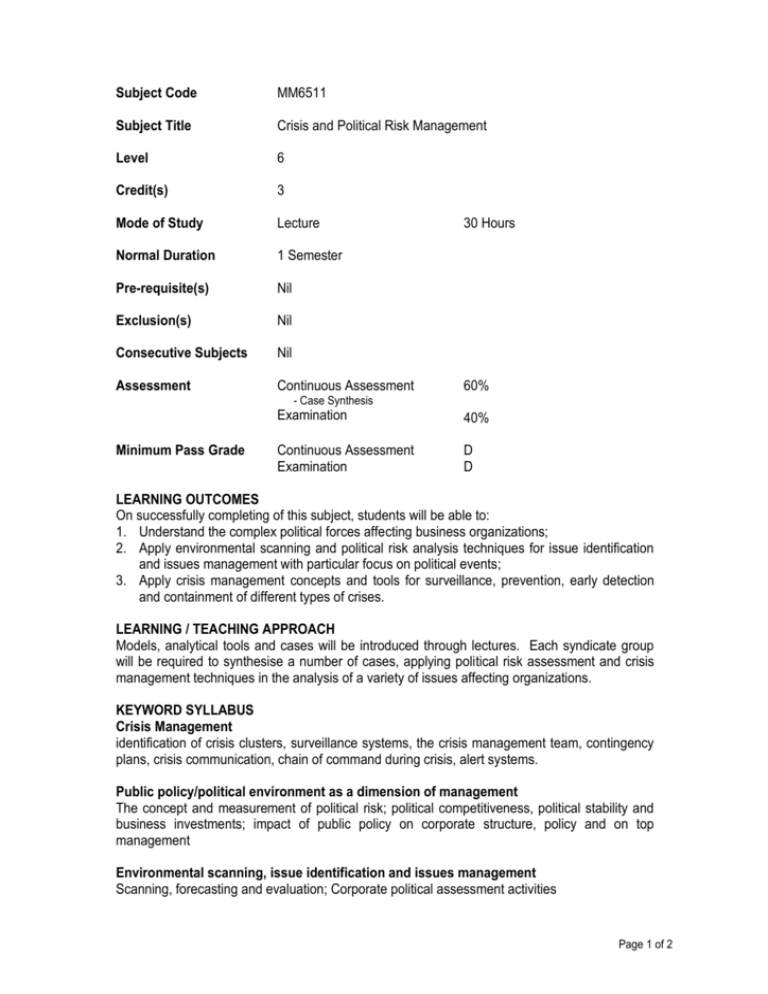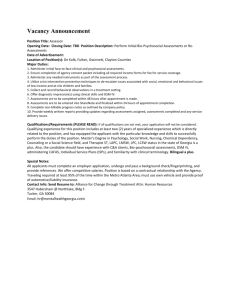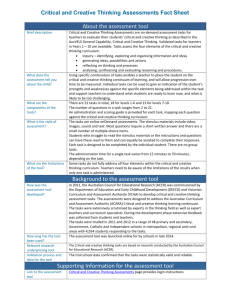Subject Code
advertisement

Subject Code MM6511 Subject Title Crisis and Political Risk Management Level 6 Credit(s) 3 Mode of Study Lecture Normal Duration 1 Semester Pre-requisite(s) Nil Exclusion(s) Nil Consecutive Subjects Nil Assessment Continuous Assessment 30 Hours 60% - Case Synthesis Minimum Pass Grade Examination 40% Continuous Assessment Examination D D LEARNING OUTCOMES On successfully completing of this subject, students will be able to: 1. Understand the complex political forces affecting business organizations; 2. Apply environmental scanning and political risk analysis techniques for issue identification and issues management with particular focus on political events; 3. Apply crisis management concepts and tools for surveillance, prevention, early detection and containment of different types of crises. LEARNING / TEACHING APPROACH Models, analytical tools and cases will be introduced through lectures. Each syndicate group will be required to synthesise a number of cases, applying political risk assessment and crisis management techniques in the analysis of a variety of issues affecting organizations. KEYWORD SYLLABUS Crisis Management identification of crisis clusters, surveillance systems, the crisis management team, contingency plans, crisis communication, chain of command during crisis, alert systems. Public policy/political environment as a dimension of management The concept and measurement of political risk; political competitiveness, political stability and business investments; impact of public policy on corporate structure, policy and on top management Environmental scanning, issue identification and issues management Scanning, forecasting and evaluation; Corporate political assessment activities Page 1 of 2 Public policy models and public policy formation process in Hong Kong, China and selected Asian-Pacific countries Elite/Mass Model The Group Model The Institutionalist Model The Rationalist, Incrementalist, and Mixed Scanning Models Public Choice Models The Prince System Applying political risk models and techniques to selected issues Risk adjusted discount rate The Economist Model The Business Environment Risk Intelligence Model (BERI) The Political Risk Services Model Moody’s Model Standard and Poor’s Model INDICATIVE READING Blank, S., Assessing the Political Environment : An Emerging Function in International Companies, The Conference Board, New York, 1990. Cantor R., Packer F., "Determinants and Impact of Sovereign Credit Ratings" Global Risk Assessments Book 4, Global Risk Assessments Inc., Riverside, 1997, pp. 65-100. Chong, J. K. S. and M.-K. Nyaw (2002). "Are Hong Kong companies prepared for crisis?" Disaster Prevention and Management, 11,1:12 Coplin, William D, and Michael K O'Leary Political Analysis through the Prince System Policy Studies Association. Dunleavy, P., Democracy, Bureaucracy & Public Choice, Harvester Wheatsheaf, London 1992. Erb, C. B., Harvey, C. R. & Viskanta, T. E., "Political Risk, Economic Risk and Financial Risk", Financial Analysts Journal, November/December 1996, pp. 29-46. Howell, L. & Chaddick, B., "Models of Political Risk for Foreign Investment and Trade" The Columbia Journal of World Business, Fall 1994, pp. 70-91. Howell, L., "Politically-Based Losses to Foreign Investors : Concept and Measurement" in Jerry Rogers (ed.) Global Risk Assessments Book 4, Global Risk Assessments Inc., Riverside, 1997, pp. 43-64. Nairne, S., "Political Risk on Shifting Sands : An Export Credit Agency's View" in Jerry Rogers (ed.) Global Risk Assessments Book 4, Global Risk Assessments Inc., Riverside, 1997, pp. 2442. Nye, R., "Sovereign Credit Ratings: A Subjective Assessment" in Jerry Rogers (ed.) Global Risk Assessments Book 4, Global Risk Assessments Inc., Riverside, 1997, pp. 101-118. Pearson, C. M. and J. A. Clair (1998). "Reframing Crisis Management." Academy of Management Review 23(1): 59-76. Pious, R. M. (2001). "The Cuban Missile Crisis and the Limits of Crisis Management." Political Science Quarterly 116(1): 81-105. Stapenhurst, F., Political Risk Analysis around the North Atlantic. St. Martin Press, New York, 1992. Shrivastava, P., I. I. Mitroff, et al. (1988). "Understanding Industrial Crises." Journal of Management Studies 25(4): 285-303. Date December 2008 Page 2 of 2









